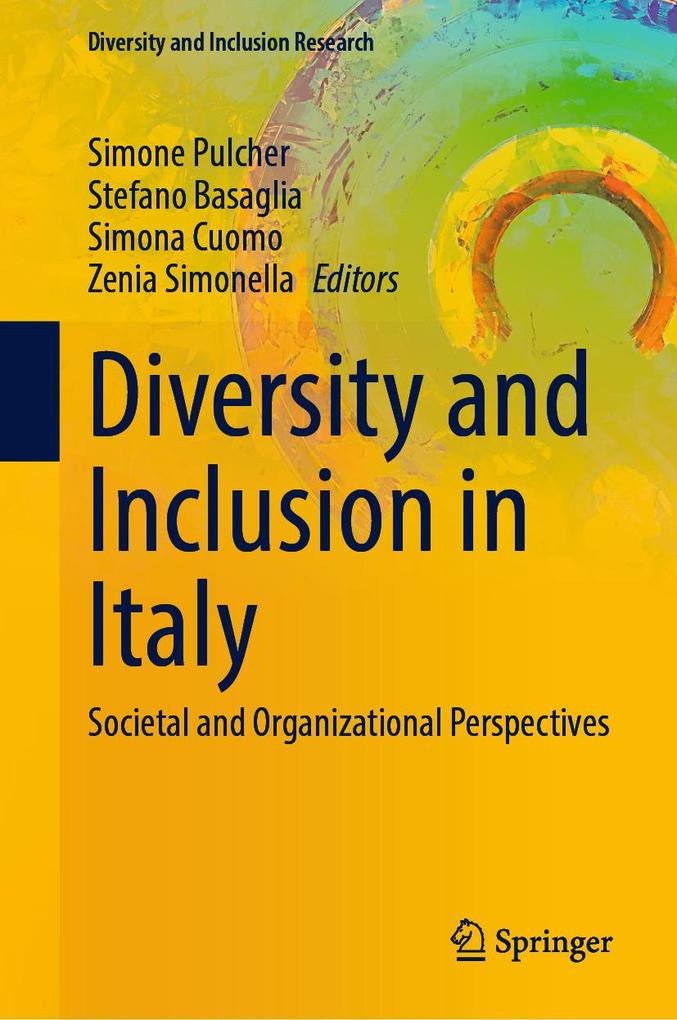
Sofort lieferbar (Download)
History, geography, culture, and the legal framework influence the dynamics of inclusion and exclusion in and around organisations. Yet, most academics and practitioners still approach themes of diversity in organisations relying on standardised discourses and practices, often transferred uncritically from the Anglo-Saxon context. Adopting a contextual approach that takes into account the specificities of the Italian context, this book explores a wide array of themes related to diversity and inclusion in organisations and society.
Focusing on the Italian context, the book offers new insights into themes already well-established in the diversity debate, such as gender, age and disability. It also provides an opportunity to reflect on categories, organisational forms, and stakeholders rarely associated with diversity, such as social class, family businesses, and trade unions, but also to consider the role of technology and the arts as tools for both inclusion and exclusion. The contributions draw on different disciplines and perspectives and provide insights relevant not only with respect to Italy but also to other national and international contexts. This volume is aimed at both researchers and practitioners who wish to develop a more nuanced and mature understanding of diversity in organisations and society.
Inhaltsverzeichnis
1. Introduction. - Part I: The history of D& I in Italy. - 2. The history of diversity in Italy from 1861 to 1945: An analysis of society, workplaces, and Businesses. - 3. The history of diversity in Italy from 1945 to 1995: An Analysis of society, workplaces, and businesses. - 4. The history of diversity in Italy from 1995 to 2024: The rise of diversity management in the age of flexibility and precarity. - Part II: Framing the Italian Context. - 5. Gender domains. Female employment and its deterrents in the Mediterranean multiverse. - 6. Religious diversity in Italy. - 7. Matters of `gender-inclusive language in Italy. Controversies, guidelines and creative practices. - 8. Social Inclusion in the Contemporary Italian Online Public Discourse. - 9. Inclusion for whom? A focus on precarious workers. - 10. Diversity in the making: Insights from the family-business research. - 11. Pathways to Diversity Management in Italian Public Administration: The INPS Case Study. - 12. Trade unions and equality, diversity, and inclusion in Italy: Bread and butter, bread and roses, or just breadcrumbs? . - Part III: Stereotypes and identities. - 13. The legitimation of LGBT+ diversity in the Italian workspace: the role of Social Movement Organizations, Trade Unions, and Firms. - 14. Trans chronicles in the Italian workplace. 15. Generational Challenges in the Italian Workplace: Myth or Reality? . - 16. The Three-Dimensional Gender and Fatherhood: a Profile of Italian men. - Part IV: Occupations, careers and processes of inclusion and exclusion. - 17. Gender and discrimination in the Italian Academy. - 18. The Advance of Women in Highly-Skilled Professions and Science in Italy: A Gender Paradox? . - 19. Careers in Italy in rocket times: does gender matter? . - 20. Class Lines at Work: The Silent Barrier HR and Diversity Managers Can No Longer Ignore. - 21. Diversity, Equity & Inclusion Practices and Immigrant Human Resources in the Italian Workplace: Pursuing Organizational and Societal Value. - 22. Unmaking marginality. Future directions in achieving Roma socioeconomic inclusion. - 23. How organisations include people with disability in the Italian context: an exploratory study. - Part V: Tools and policies for inclusion. - 24. Organizational approaches and communication practices to support DEI in the Italian workplace. - 25. The adoption of gender quotas in Italian companies. - 26. Intercultural Mediators in the Italian Legal System. - 27. Lights and Shadows in the Italian Gender Mainstreaming. - 28. Key players in gender-responsive budgeting: An empirical analysis in Italian universities. - 29. Young people NEET in Italy: Exploring the phenomenon and evolving policies. - Part VI: Technology and art as form of oppression or emancipation. - 30. Inclusive technologies, exclusive practices: on the fluidity of technology in diversity management processes. - 31. Hybrid Ways of Working in The Digital Era in Italy: Key Questions for Moving Forward. - 32. From the invisible oppression to the visible liberation: Intersectionality and Intrasectionality as tools to address Epistemic Injustice in education. - 33. Dance-led learning and inclusion: arts-based methods and the emergence of new categories about diversity.
Produktdetails
Erscheinungsdatum
05. Mai 2025
Sprache
englisch
Seitenanzahl
738
Dateigröße
15,31 MB
Reihe
Diversity and Inclusion Research
Herausgegeben von
Simone Pulcher, Stefano Basaglia, Simona Cuomo, Zenia Simonella
Verlag/Hersteller
Kopierschutz
mit Wasserzeichen versehen
Produktart
EBOOK
Dateiformat
PDF
ISBN
9783031819384
Entdecken Sie mehr
Bewertungen
0 Bewertungen
Es wurden noch keine Bewertungen abgegeben. Schreiben Sie die erste Bewertung zu "Diversity and Inclusion in Italy" und helfen Sie damit anderen bei der Kaufentscheidung.









